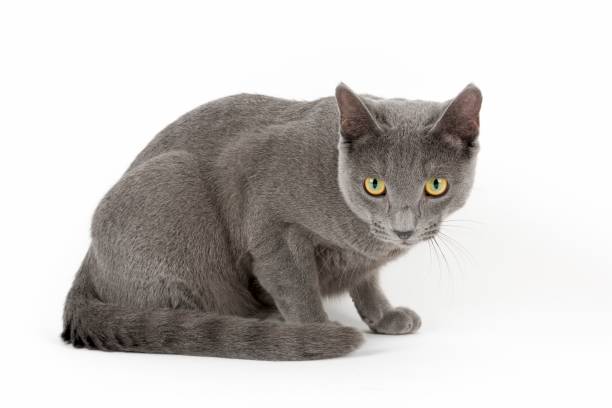
The Russian blue is a beautiful cat with a distinct blue-gray coat. They have a friendly personality but will disappear at the sight of strangers. So, without further ado, here’s the guide to the Russian Blue cat!
Origin:

Not much is known about this breed, but it’s believed to be originated from the Archangel Isles in northern Russia. The Cat Fanciers’ Association (CFA) says that rumor is “the Russian blue breed descended from the cats kept by the Russian Czars. Assuming the Russian blue did migrate from northern Russia, it was likely via ship to England and northern Europe in the mid-1860s.” The Russian Blue made its first public debut in 1875, where it was imported into London’s Crystal Palace. They were later given their own categorization by 1912 after their establishment in the U.S. in the early 1900’s. According to the CFA, these cats really got the attention of pet lovers after WWll (World War ll), and it was gaining its popularity since the 1960’s.
Appearance:

The Russian Blue has a luxurious, plush coat of fur which has a nice blue hue with a shiny silver sheen. Their eyes are yellow as kittens, but they turn a brilliant green color by the age of 4 months. They have a wedge-shaped head and a unique muzzle and mouth which makes them look like they’re smiling. This cat can be a good choice for people with allergies, because that thick coat keeps allergens close to the skin. They don’t shed much either, so minimal grooming is needed.
Personality:
The Russian Blue cat is sweet-tempered and a very loyal companion. They will show a lot of affection to the whole family but also wants it in return. While these kitties like being with their owners, they like to spend time alone too. They won’t mind you being at work all day, but if you’re home, it’s playtime! Russian blues aren’t exactly the kind of cat that likes strangers. If there’s a party at your house, your cat will be out of sight!
Diet:
Russian blues should have a diet that’s meat rich but low in carbs so she will have the nutrients and water she needs. Russian Blues should have more wet food than dry, but make sure dry food is part of her diet. Here’s a list of the best cat food for this particular breed (in 2022):
- Friskies Shreds Variety Pack Canned Cat Food
- Wellness CORE Natural Grain Free Wet Canned Cat Food
- Fancy Feast Classic Collection Chicken & Beef Pate
- Hill’s Science Diet Indoor Chicken Recipe Dry Cat Food
- iki Pets Tiki Cat Luau Wet Food Salmon
- AvoDerm Natural Indoor Weight Support Recipe Adult Canned Cat Food
- Blue Buffalo Blue Basics Limited Ingredient Duck & Potato Pate Cat Food
- Natural Balance L.I.D. Limited Ingredient Green Pea & Duck Formula Grain-Free Dry Cat Food
You can research other recommendations, or ask your local animals shelter.
Health Problems:
Russian blue cats are active and cute, but yes, they have health problems. Some of them include:
- Asthma
- Atopy
- Conjunctivitis
- Diabetes
- Feline Aortic Thromboembolism (FATE)
- Feline Infectious Peritonitis (FIP)
- Feline Lower Urinary Tract Diseases (FLUTD)
- Hyperthyroidism
- Hypertrophic Cardiomyopathy
- Kidney disease
- Obesity
Here’s a link that explains these diseases: Russian Blue Cat Health Problems: 11 Common Concerns | Pet Keen
Thats that! You can research more about this breed of cat. Until then, see you next time!
